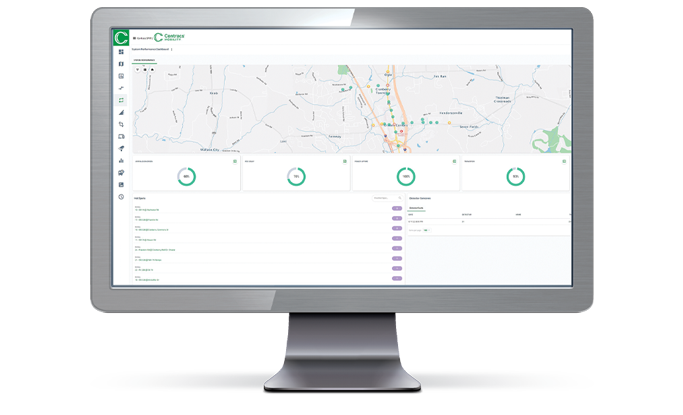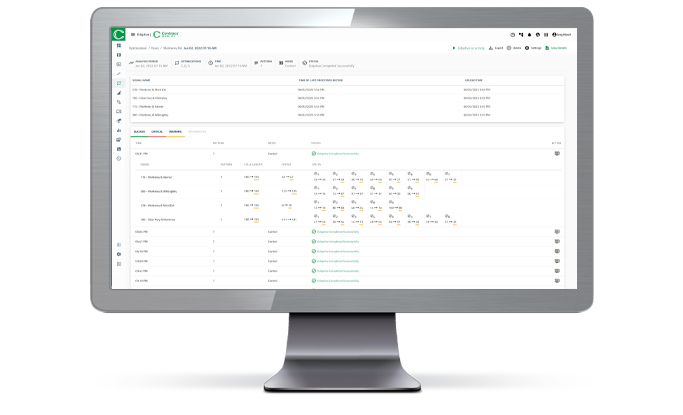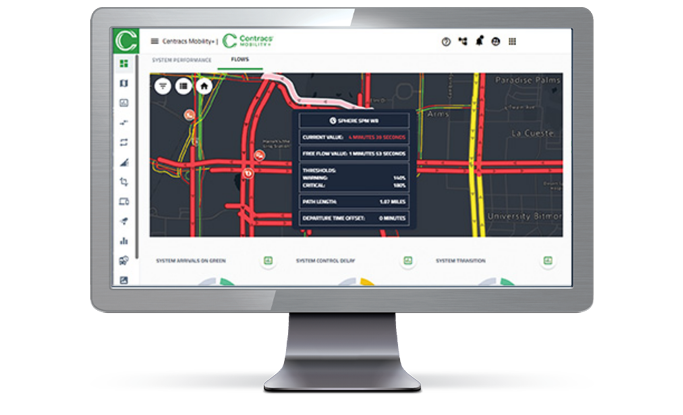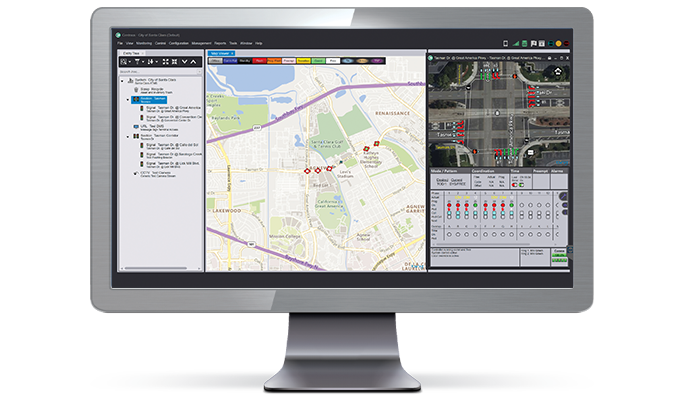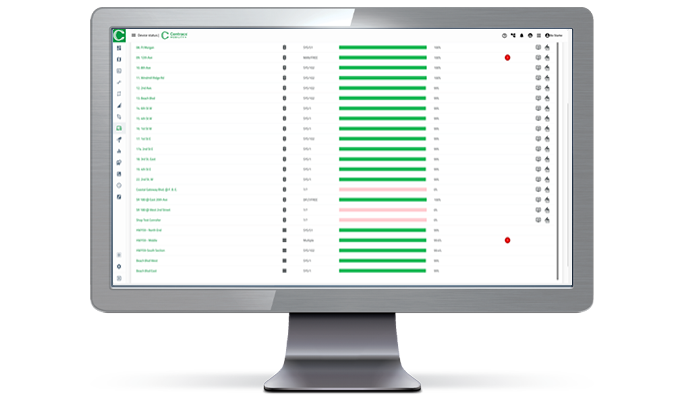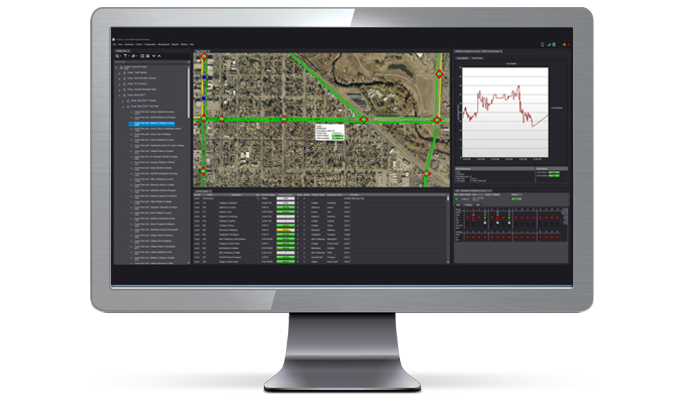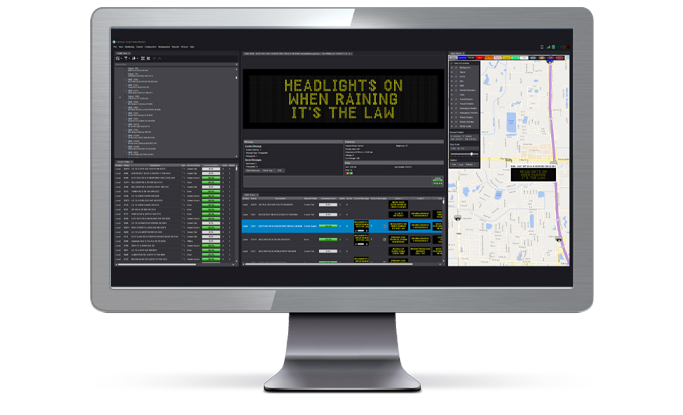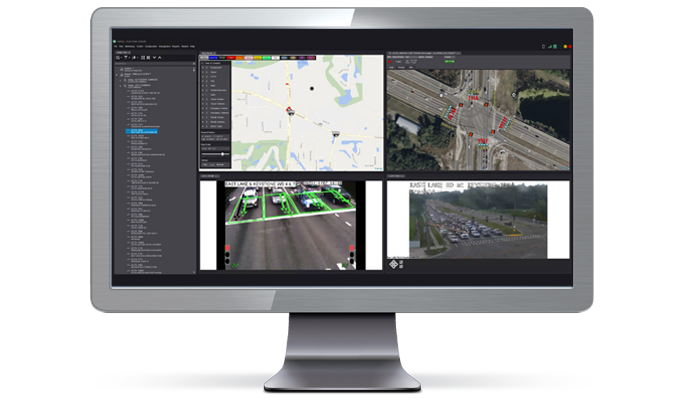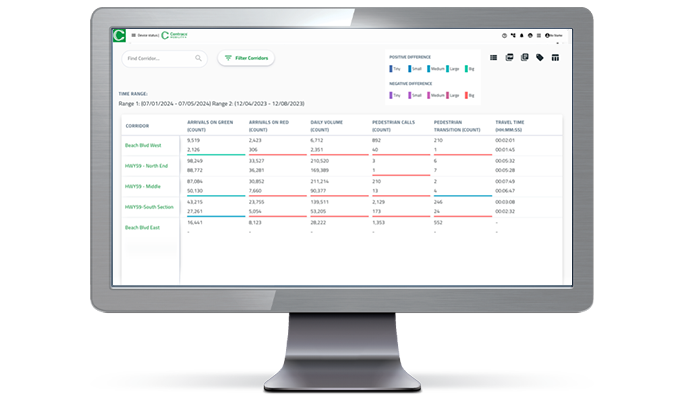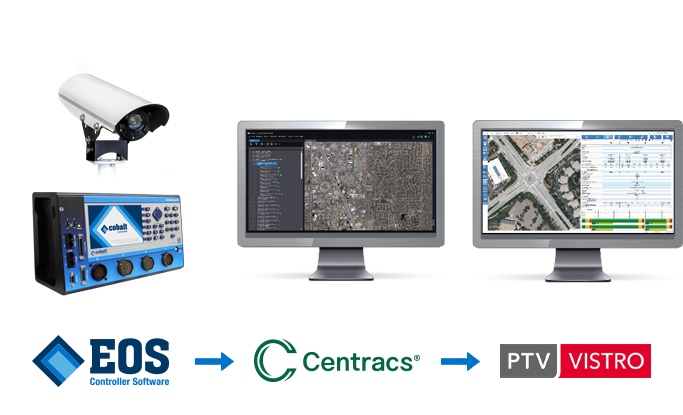Advanced Traffic Management Systems (ATMS)
An ATMS is vital for creating safer, more efficient, and sustainable transportation networks. By leveraging real-time data and adaptive signal control, it optimizes traffic flow, reduces congestion, and improves travel times. ATMS enhances safety through automated incident detection and rapid response, lowers environmental impact by reducing fuel use and emissions, and supports public transit with greater reliability and multimodal integration. Dynamic routing and signal priority also enable faster emergency response. ATMS empower cities to become smarter and more resilient by improving mobility, safety, and sustainability.

What an Advanced Traffic Management System (ATMS) Is
ATMS is a sophisticated and powerful advanced transportation management system software platform that dynamically manages roadway networks to improve efficiency, safety, and reliability. An ATMS software solution is a key component of Intelligent Transportation Systems (ITS) and integrates traffic and roadway data from various sources, such as cameras, speed sensors, and traffic detectors, to help cities optimize traffic mobility.
ATMS aims to enhance mobility, improve safety, reduce fuel consumption, and minimize environmental impact by optimizing traffic operations
Key Features and Components of ATMS
Enhancing Mobility, Reducing Congestion, and Boosting Safety with Cutting-Edge ATMS Solutions. An advanced transportation management system is at the heart of modern urban planning, designed to enhance mobility, safety, and efficiency across road networks. These platforms leverage cutting-edge technology to make cities smarter and traffic smoother.
Real-Time Data Collection and Analysis
One of the key components of an advanced traffic management system is its ability to collect and analyze data in real time. Sensors, cameras, and connected devices stream information about traffic flow, vehicle speed, and environmental conditions. This empowers traffic authorities to make proactive decisions, reduce congestion, and respond to changing patterns instantly.
Integration with Intelligent Transportation Systems (ITS)
Advanced systems are built to interface seamlessly with intelligent transportation systems, including smart signs, connected vehicles, and transit platforms. This integration promotes cohesive traffic management, enabling vehicles and infrastructure to communicate and coordinate for optimal flow and safer travel.
Dynamic and Adaptive Signal Control
Unlike traditional signal systems, intelligent traffic management incorporates dynamic signal control that adjusts in response to actual traffic conditions. Signals adapt based on demand, reducing delays and fuel consumption while improving travel times for all modes of transportation.
Incident Detection and Response Automation
Through real-time monitoring and machine learning algorithms, an advanced transportation management system quickly identifies accidents, breakdowns, or unusual events. Automated alerts and coordinated emergency response minimize disruption and enhance public safety.
Together, these technologies form a robust framework for intelligent traffic management—creating more efficient, resilient, and responsive transportation networks. Whether reducing commute times or managing emergency situations, these systems represent a crucial step toward smarter, safer cities.
Advanced Traffic Management in Action: Use Cases
Urban Traffic Optimization and Congestion Reduction
An advanced transportation management system plays a pivotal role in reducing urban congestion and streamlining traffic operations. By leveraging real-time data and predictive analytics, city planners and traffic authorities can proactively manage road networks and anticipate traffic buildups before they happen.
Smart Signal Coordination
With smart traffic management, traffic signals adjust dynamically based on vehicle volumes and pedestrian flow. This reduces idle times at intersections, improving overall traffic efficiency and decreasing emissions from idling vehicles.
Incident Management and Routing
Through real-time monitoring and machine learning algorithms, an advanced transportation management system quickly identifies accidents, breakdowns, or unusual events. Automated alerts and coordinated emergency response minimize disruption and enhance public safety.
Predicting and Forecasting Congestion
Through real-time monitoring and machine learning algorithms, an advanced transportation management system quickly identifies accidents, breakdowns, or unusual events. Automated alerts and coordinated emergency response minimize disruption and enhance public safety.
An advanced transportation management system helps metropolitan areas move toward cleaner, faster, and more reliable mobility. With the right deployment of smart traffic management tools, cities can reclaim their streets—making every journey smoother and safer.
Emergency Response and Incident Management
When seconds matter, an ATMS traffic management system ensures rapid coordination between agencies and quick decision-making during emergencies. By integrating real-time traffic data with emergency services, cities can streamline operations and dramatically reduce response times.
Real-Time Emergency Routing
Using dynamic traffic management, emergency vehicles receive optimized route guidance that adapts instantly to changing road conditions. Traffic signals can be overridden to provide green waves, enabling faster and safer passage through urban environments.
Incident Detection and Resolution
An advanced traffic management system automatically detects road incidents like collisions or breakdowns via sensors and surveillance feeds. Traffic operators receive instant alerts, allowing swift deployment of responders and implementation of detours to minimize impact on traffic flow.
Multi-Agency Coordination Platform
A centralized interface built on advanced transportation management systems empowers police, fire, medical, and traffic control teams to collaborate seamlessly. This shared visibility ensures a unified response strategy and real-time communication across sectors.
An ATMS that incorporates these operational capabilities help cities maintain emergency response resilience and keep its citizens safe. With smart investments in dynamic traffic management, emergency services become more responsive and capable of handling unexpected events with precision and agility.
Advanced Public Transport Management Integration
Modern cities are turning to advanced transportation management systems to improve the efficiency and reliability of public transit. Through seamless integration with an advanced traffic management system, transit agencies can optimize service routes, reduce delays, and enhance rider satisfaction.
Transit Signal Priority (TSP)
With dynamic traffic management, buses and trams can receive priority at intersections using real-time traffic flow data. Traffic signals are adjusted to allow quicker passage for transit vehicles, resulting in reduced travel times and improved schedule adherence.
Schedule Reliability and Optimization
An advanced public transport management platform enables real-time vehicle tracking, traffic signal priority, and route load balancing. This helps transit operators make data-driven decisions to avoid delays and improve operational efficiency.
Integrated Multimodal Coordination
Connecting public transport with other modes—like bike sharing and rideshare—through a centralized advanced transportation management system ensures smooth transitions for commuters. Real-time updates allow travelers to adapt routes and avoid delays.
An advanced public transport management system managed by an ATMS empowers cities to build smarter and greener transit networks. With advanced traffic management and transit-focused innovation, public transport becomes not just a choice—but the preferred way to move.
Econolite’s ATMS Product Suite
Centracs ATMS advanced transportation management system solution currently powering more than 500 cities and municipalities across North America and controlling over 60,000 signalized intersections. Centracs goes well beyond that of traditional traffic control, enabling users to harness the power of Advanced Traffic Management to reduce traffic congestion, enhance safety, and optimize mobility for humanity.
Centracs® Mobility: Optimizing Mobility
The Centracs® Mobility cloud-based ATMS software platform offers a comprehensive suite of powerful traffic management modules that combine the robust capabilities of Centracs with the cutting-edge functionality of Centracs Mobility advanced transportation management system.
Centracs Mobility delivers unparalleled flexibility and scalability, supporting an array of urban and regional system deployment options, real-time data analytics, third-party data integration, remote monitoring, AI and machine learning for predictive operations, and more to optimize traffic management control and operations, while ensuring optimal efficiency.
Key Features of Centracs Mobility
- Real-time, dynamic COS adjustments (Centracs Edaptive)
- Historical pattern-based time of day strategies (Centracs Pattern Optimizer)
- Real-time, automated pattern-based optimization leveraging probe data (Centracs Traffic Responsive)
- Predicted, automated pattern-based optimizations (Centracs Traffic Proactive)
Key Features of Centracs Mobility with PTV Flows
- Advanced Machine Learning
- Detectorless insights and control
- Predictive traffic forecasts
- Automated dynamic traffic management via Centracs Traffic Proactive
- Unmatched scalability and data depth
Future Trends in Advanced Traffic Management
ATMS Leveraging AI and Machine Learning to Deliver Forecasting and Predictive Operations
Cities worldwide are embracing AI and machine learning to revolutionize how traffic moves. By integrating these technologies into an advanced transportation management system, urban planners can forecast congestion patterns and optimize signal operations with unmatched precision.
Predictive traffic signal control powered by machine learning continuously analyzes traffic data to forecast peak travel times and adjust signal timings proactively. This dynamic traffic management reduces delays and enhances intersection efficiency—especially during rush hour or special events.
AI algorithms detect recurring congestion hotspots and bottlenecks, automatically triggering strategic changes to traffic signal cycles and lane use. This contributes to smarter traffic management and optimization, minimizing stop-and-go conditions across key corridors.
As conditions evolve, the system adaptively learns and deliver real-time refinement. From historical trends and current flows, adapting traffic signals on the fly, enabling smoother journeys, lower emissions, and a better experience for all roadway users.
These innovations reshape traffic management and optimization into a predictive, responsive ecosystem. With AI-enabled advanced transportation management systems, cities can stay one step ahead of congestion.
Integrating Smart Cities with Dynamic Traffic Solutions and Applications
In the evolution toward smarter cities, an advanced transportation management system serves as the digital backbone for mobility. By integrating with urban infrastructure and IoT devices, cities can deploy dynamic traffic management solutions that enhance real-time responsiveness and long-term sustainability.
Advanced traffic management systems aggregate and analyze traffic data from sensors, cameras, and vehicles, creating a unified platform for decision-making. This empowers municipalities to manage congestion proactively through traffic management and optimization strategies.
Dynamic traffic management technologies adjust traffic flow based on real-time conditions. Smart signals, lane control systems, and rerouting algorithms work together to minimize delays and maximize throughput, even in unpredictable scenarios like weather changes or road incidents.
Smart City platforms built on advanced transportation management systems provide users with traffic updates, alternate routes, and transit options via push notifications on mobile apps and dashboards. These tools encourage behavior shifts toward more efficient travel patterns, especially for active mobility users.
By integrating traffic management and optimization tools into Smart City frameworks, urban centers create more agile, sustainable, and accessible mobility ecosystems, paving the way for the cities of tomorrow.
Why Choose Econolite for Your ATMS Needs
Pioneers of Proven Advanced Traffic Management Solutions
Econolite stands as the industry leader in delivering proven advanced traffic management system solutions. For over 92 years, Econolite has been at the forefront of designing advanced transportation management systems that power smarter, safer, and more efficient mobility. Our cutting-edge advanced traffic management system software leverages real-time data, predictive analytics, and automation to optimize ATMS traffic operations. From dynamic signal control to integrated ATMS software platforms, Econolite continues to shape the future of intelligent infrastructure. With a legacy of innovation in ATMS traffic management, Econolite empowers cities to transform their roadways through scalable, reliable, and future-proof solutions.
Customized ATMS Design and Engineering for Urban and Regional Needs
Econolite delivers customized design and engineering of advanced traffic management systems to meet the unique demands of urban and regional communities. With deep expertise in ATMS and advanced traffic management system software architecture, Econolite integrates adaptive technologies to optimize ATMS traffic operations. Our ATMS solutions are designed for large urban networks to growing rural or suburban areas. Econolite’s scalable ATMS traffic management solutions ensure smoother mobility, improved safety, and smarter infrastructure. Our versatile ATMS software is built to support evolving needs with precision and reliability. From concept to deployment, Econolite transforms traffic challenges of all sizes into intelligent transportation achievements.
Get Started with Econolite’s ATMS
Discover how Econolite’s advanced transportation management system solutions can transform your city.
Contact Us for a Consultation / Request a Demo or Case Study Overview
Advanced Traffic Management Systems FAQs
Q: What are the core components of ATMS?
A: ATMS includes the centralized software application, providing intersection control and the traffic management software platform that additional ITS applications can be integrated, including our comprehensive suite of modules.
Q: How does ATMS improve public transport efficiency?
A: An advanced traffic management system provides dynamic traffic signal control for transit vehicles. Integrating with existing CAD/AVL and GTFS systems, Priority uses vehicle position and AI for Transit Signal Priority (TSP) to maintain consistent headways, on-time performance, and schedule reliability for public transport operations.
Q: Is ATMS suitable for smart city integration?
A: An ATMS is designed for and represents a fundamental part of the Smart City infrastructure ecosystem. ATMS optimizes mobility, helping connect communities and building a more sustainable future.
Q: What industries benefit from ATMS solutions?
A: ATMS delivers the smart technologies and capabilities that cities, municipalities, and states need to strengthen and enhance surface transportation infrastructure, benefiting commerce and humanity.
Q: How do Econolite’s products support ATMS implementation?
A: Econolite’s products, systems, and solutions deliver unparalleled flexibility and scalability, supporting an array of system deployment options, real-time data analytics, third-party data integration, remote monitoring needed for ATMS to optimize traffic infrastructure operations and ensure peak operational efficiencies.
Cabinets
Traffic Controllers
Systems Deployed
Sensors Installed

